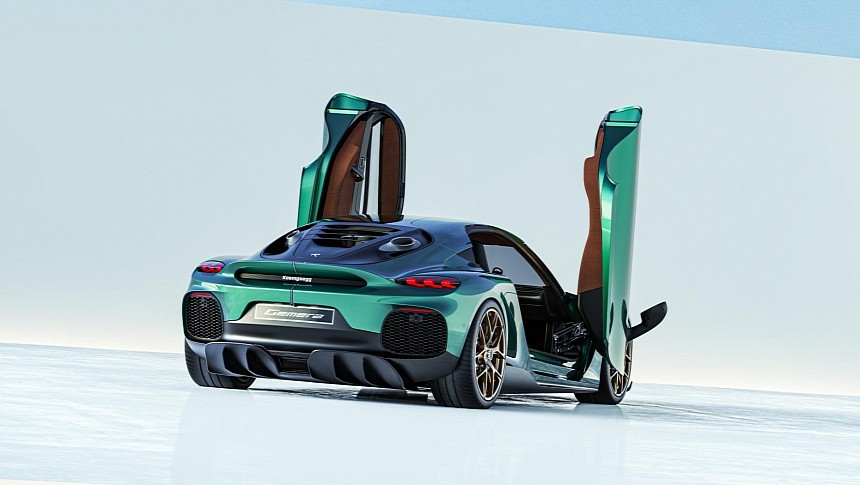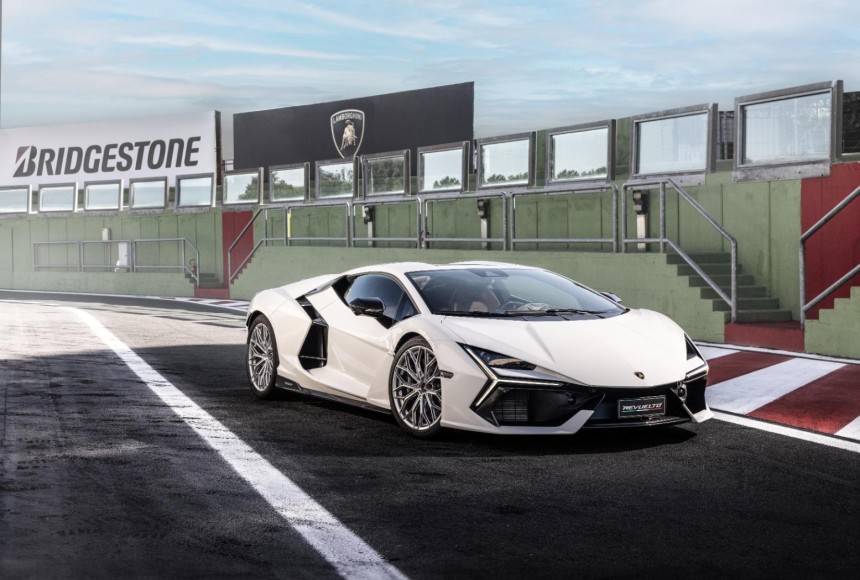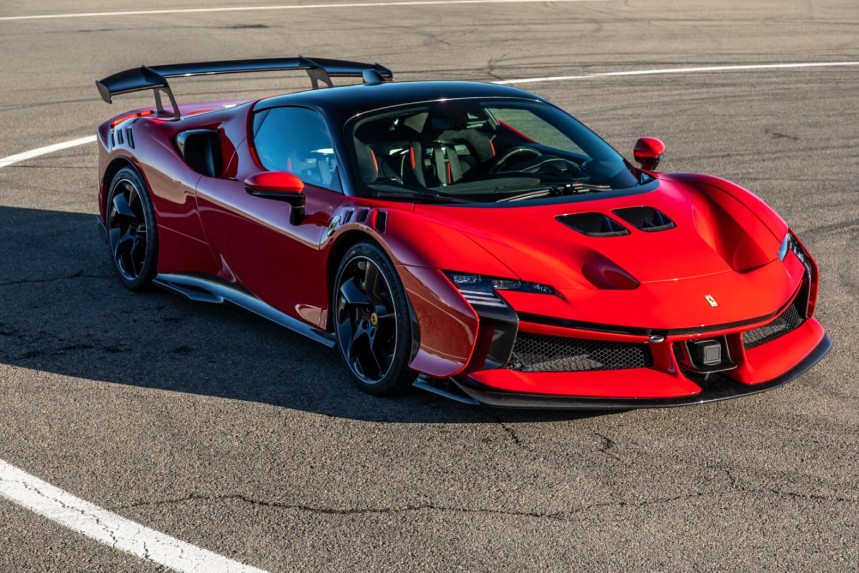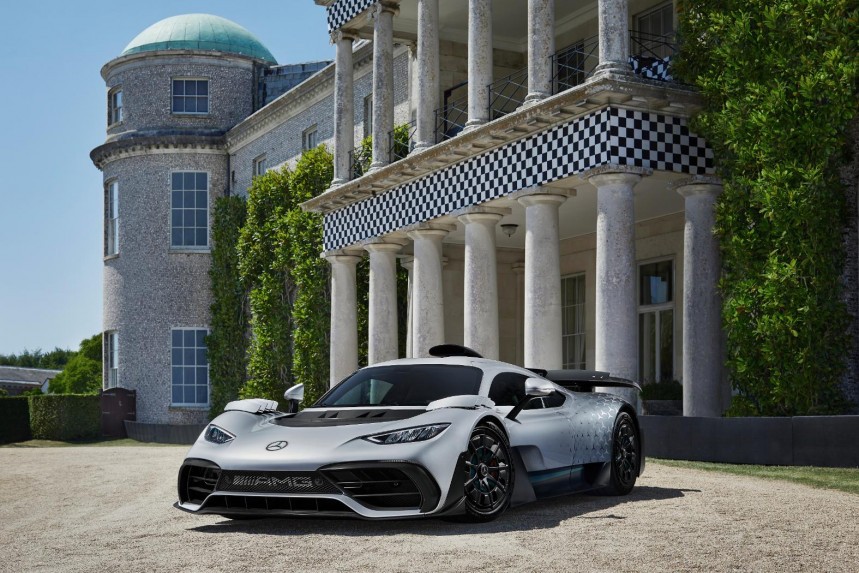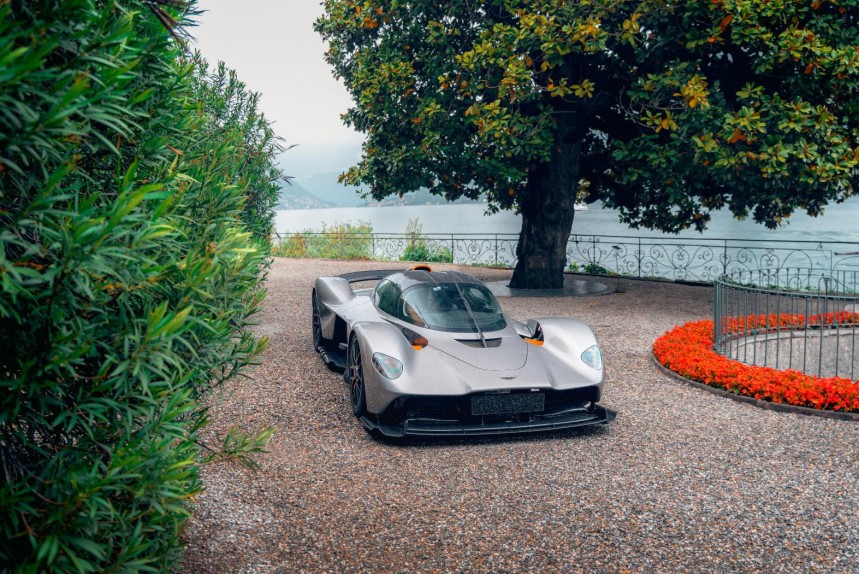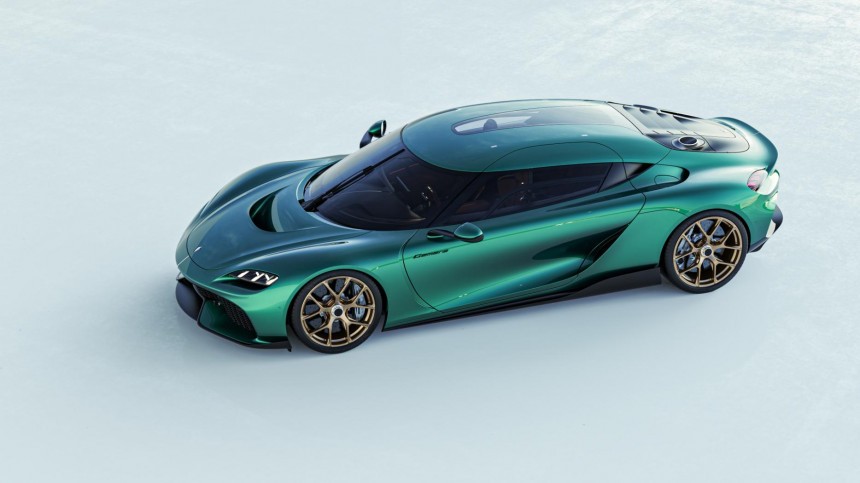Almost three decades after Honda and then Toyota helped introduce and popularize the hybrid setup on mainstream passenger cars, we can now drive 1000+ horsepower hybrid supercars.
At first, hybrid cars were mainly used to feel like you are taking care of the planet by replacing your gas guzzler with a (usually) gutless econobox that looks a bit weird but sips fuel like it doesn't really need it.
As the technology of electric motors and especially batteries progressed, even luxury cars jumped on the hybrid bandwagon. The extra oomph brought by electric motors and their instant torque output at zero rpm saw them quickly introduced to performance cars as well.
It wasn't long until the first-ever hybrid hypercars appeared in 2013, which materialized in the gorgeous shapes of the so-called Hypercar Holy Trinity (HHT), comprising the Ferrari LaFerrari, McLaren P1 and the Porsche 918 Spyder.
While LaFerrari technically was a mild-hybrid on steroids, combining a KERS system with a naturally aspirated V12, the 918 Spyder and the P1 were plug-in hybrids, combining multiple electric motors with a N/A V8 in the Porsche and a twin-turbo V8 in the McLaren.
With total outputs ranging from 875 HP (887 PS) to 950 HP (963 PS) and top speeds of well over 200 mph (322 kph), the Holy Hypercar Trinity wasn't even in the same ballpark as a Toyota Prius or any other hybrid car before them. That said, it was a pack of hybrids like never before, creating a paradigm shift in the supercar and hypercar scene.
About a decade later, whoever is looking for a mix of hybrid technology and supercar performance is almost spoiled for choice. Over 90 percent of supercars and hypercars coming in the next couple of years will have a powertrain with some form of electric assistance, if not fully electric. Even Porsche is going hybrid with the 911 lineup for the 992.2 facelift.
As I keep mentioning, cars have evolved following a logarithmic scale in the last few years. So, while the Holy Hypercar Trinity offered mind-blowing performance a decade ago, mere supercars from the current age are already better performing.
All we need to calculate the huge jump in hybrid performance for modern exotic cars is to look at the five most powerful ones you can buy today. Even the least potent hybrid supercar from 2023 one-ups the Ferrari LaFerrari, which had won the horsepower race with Porsche and McLaren a decade ago.
Coming in at number five, we find the Lamborghini Revuelto, unveiled as the brand's flagship production model for the upcoming years, as we slowly transition toward a zero-emission future.
The Revuelto marks a significant milestone as the first Lamborghini model to embrace a plug-in hybrid propulsion system. While earlier models, such as the Sian FKP 37 and Countach LPI 800-4, incorporated a mild-hybrid system to enhance low-speed driveability, the Revuelto distinguishes itself as the first-ever Lamborghini to feature a full-fledged hybrid drivetrain.
Unveiled during the carmaker's 60th anniversary year, the model signals how much Lamborghini has evolved since the early days, when its founder started the company out of spite.
Compared to its predecessor, the Aventador, the Revuelto packs a much more powerful punch. This is thanks to a naturally aspirated, 6.5-liter V12 paired with no less than three electric motors, each delivering 150 PS (148 HP) and a 3.8 kWh lithium-ion battery that gives it a 10 km (6 miles) emission-free range.
Two electric motors power the front wheels, while the third one is integrated into the transmission, which sits behind the engine.
The combined output is a cool 1001 horsepower (1,015 PS), more than any of the HHT cars and more than the Bugatti Veyron, for example. That said, it is still the least powerful supercar on this list, believe it or not.
The extensive use of carbon fiber and high-strength aluminum in its monocoque chassis makes it lighter than the Aventador's, with the Revuelto having the best weight-to-power ratio in the history of Lamborghini. Each metric horsepower only has to carry 1.75 kg (3.8 pounds), despite the extra heft brought by the hybrid system and the addition of an 8-speed dual-clutch transmission.
The model can hit 100 kph (62 mph) from a standing start in just 2.5 seconds thanks to the downright scary specifications and all-wheel-drive, while improved aero can take it to over 350 kph (217 mph).
While the Lamborghini Revuelto stole some of the thunder from the SF90 Stradale regarding power, Ferrari recently counter-attacked with the limited series, track-focused SF90 XX Stradale.
Unlike previous 'XX' models like the FXX, 599XX, and FXX-K, the Ferrari SF90 XX Stradale is completely road-legal despite having been developed for ultimate track performance. I say 'ultimate' because it is one of the most aerodynamically efficient Ferrari road cars in history.
To put things into perspective, the last road-legal Ferrari to sport a fixed rear wing was the F50, on which it delivered up to 315 kg (694 lbs) of downforce at 250 kph (155 mph). The wing on the SF90 XX Stradale delivers up to 530 kg (1,198 lbs) of downforce.
Apart from the high-tech aerodynamics package, most of the model's performance comes from the powertrain, which, like the Lamborghini Revuelto, consists of an internal combustion engine and three electric motors.
Unlike the Revuelto, the SF90 XX Stradale uses a twin-turbocharged, 4.0-liter V8 paired with three electric motors, two of which making the car all-wheel-drive by powering the front wheels.
Thanks to a larger, 7.9 kWh battery, the Ferrari plug-in has a 24 km (15 miles) all-electric range, but the 'XX' in its name should tell you that this Prancing Horse is anything but a civilized car that you take to the opera.
Instead, Ferrari has concentrated on making it perform at the highest level on the race track. The model's impressive aerodynamics, all-wheel-drive, and 1,030 PS (1,016 HP) combined output make it go from 0 to 100 kph (62 mph) in just 2.3 seconds.
Because of the same aerodynamics that makes it stick to the road, the SF90 XX Stradale's top speed is not as impressive, with the car topping out at 'only' 320 kph (199 mph).
With a gestation that took quite a bit longer than initially expected and following numerous delays, the Mercedes-AMG One was finally revealed in 2022, five years after the near-production concept took center stage at the 2017 Frankfurt Motor Show.
As the first-ever road car to be powered by a Formula 1-derived powertrain, the Mercedes-AMG One was a tricky beast to develop and will probably remain the only hypercar of its kind.
Like the Revuelto and the SF90 XX Stradale, the AMG monster and current Nurburgring-Nordschleife lap record holder is a plug-in hybrid. Its turbocharged, 1.6-liter V6 is based on the same powertrain as the W06 F1 car, which won Lewis Hamilton's third Championship.
Alongside the V6 sit not one, not two, not three, but four electric motors, two of which are dedicated to powering the front wheels. Because it needed to comply with road car regulations, the engine was detuned to have a 1,280 rpm idle and an 11,000 rpm redline.
With that in mind, it is still a race engine at heart, and lucky Mercedes-AMG One owners will need to return their cars to AMG for a complete engine overhaul every 50,000 km (31,000 miles).
Apart from the two motors powering the front axle, the complex powertrain uses a motor generator unit-kinetic (MGU-K) connected to the crankshaft and a motor generator unit-heat (MGU-H) coupled to the turbocharger, just like a modern Formula 1 car.
The 0 to 100 kph (62 mph) time of 2.9 seconds may not be as impressive, but the electronically limited 352 kph (219 mph) top speed is, especially on a car that can offer almost 700 kg (1,543 pounds) of downforce.
Continuing a tradition of V-themed nomenclature at Aston Martin, the Valkyrie was named after the Norse mythological figures who guided the souls of Vikings who had fallen into battle.
The model is a product of a collaboration between Aston Martin and Red Bull Racing to develop a track-oriented hypercar that can be used on the street and is fully road-legal. Formula 1's most accomplished designer, Red Bull Racing's Chief Technical Officer Adrian Newey, aided in the design of the Aston Martin Valkyrie.
At the heart of the car sits a Cosworth-developed, 6.5-liter V12 that is naturally aspirated and has a screaming 11,100 rpm redline. Unlike the three cars above, the Valkyrie is a regular hybrid, not a PHEV, and the V12 benefits from an additional 160 horsepower from a single electric motor.
The electric motor gets its electron juice from a 1.3 kWh hybrid battery system with a KERS function supplied by Rimac, meaning that, unlike the others, the Valkyrie doesn't feature any meaningful electric range.
The total output is an impressive 1,172 PS (1,160 HP) sent to the rear wheels through a single-clutch automated manual. Despite being rear-wheel-drive only, the low weight and extreme downforce help the Valkyrie go from 0 to 100 kph (62 mph) in just 2.6 seconds.
With a total weight of 1,030 kg (2,271 lb), it surpasses the magic 1:1 power-to-weight ratio with 1,126 hp per ton. The real magic trick is how that Newey designed underfloor helps the Valkyrie achieve a monumental 1,800 kg (3,968 pounds) of downforce at high speed.
Because of the limited interior space, the driver's seat is crafted to match the unique contours of the owner's body using 3D scanning technology.
Little by little, Koenigsegg has become known as one of the most influential and innovative boutique supercar-makers in the world, despite having an annual car production calculable by using your fingers. In a little over two decades, the Swedish company has transitioned from pure performance to avant-garde, which is no mean feat for such a small carmaker.
Their latest product is a perfect testament to how big ideas can be implemented by small companies, as the Koenigsegg Gemera is not only the most powerful hybrid supercar (or megacar, as Koenigsegg calls it) on the planet but also one of the most innovative.
In fact, 'innovative' is the word of the day for the Gemera, as it comes with several firsts, not excluding the downright incredible specifications, which shame even a Bugatti Chiron.
Like most of the other cars on this list, the Koenigsegg is a plug-in hybrid with a ton of power, but that is where the similarities end because the Gemera is an entirely new breed of vehicle - the world's first hypercar GT.
As Koenigsegg's first-ever four-seater, the model seamlessly blends the space and comfort of a grand tourer with the performance of a modern hypercar, and it achieves that with the help of some ground-breaking solutions.
Firstly, the so-called base model uses a twin-turbocharged, camless three-cylinder engine, a world's first, which develops 590 HP (598 PS) and 443 lb-ft (600 Nm) from a 2.0-liter displacement. Even more unusual is the fact that it powers the front wheels, despite being placed in a midship configuration. It's no wonder that its official name is TFG (Tiny Friendly Giant).
Secondly, unlike the three-motor setup of the concept, the production version also employs the world's most powerful automotive-grade electric motor with 6-phase technology. The patent-pending "raxial-flux" electric motor delivers no less than 800 HP (811 PS) and 992 lb-ft (1250 Nm) of torque.
Combined, the two powertrains deliver a massive 1,400 hp (1,419 PS) and 1,364 lb-ft (1,850 Nm) of torque sent to all four wheels. That is not all, because as a half-a-million option, Koenigsegg gives you the choice to replace the TSG engine with the 5.1-liter, twin-turbocharged V8 found in the Jesko.
With the V8, the Gemera has a staggering combined output of 2,300 HP (2,331 PS) and a mind-bending 2,028 lb-ft (2,750 Nm) of torque. Both engines are mated to the 9-speed Light Speed Transmission found in the Jesko, helping the car reach a top speed of at least 400 kph (249 mph). Called Dark Matter, the raxial-flux electric motor gets its electron juice from an 850V 14 kWh battery pack that also delivers an all-electric range of 31 miles (50 km).
As the technology of electric motors and especially batteries progressed, even luxury cars jumped on the hybrid bandwagon. The extra oomph brought by electric motors and their instant torque output at zero rpm saw them quickly introduced to performance cars as well.
It wasn't long until the first-ever hybrid hypercars appeared in 2013, which materialized in the gorgeous shapes of the so-called Hypercar Holy Trinity (HHT), comprising the Ferrari LaFerrari, McLaren P1 and the Porsche 918 Spyder.
While LaFerrari technically was a mild-hybrid on steroids, combining a KERS system with a naturally aspirated V12, the 918 Spyder and the P1 were plug-in hybrids, combining multiple electric motors with a N/A V8 in the Porsche and a twin-turbo V8 in the McLaren.
With total outputs ranging from 875 HP (887 PS) to 950 HP (963 PS) and top speeds of well over 200 mph (322 kph), the Holy Hypercar Trinity wasn't even in the same ballpark as a Toyota Prius or any other hybrid car before them. That said, it was a pack of hybrids like never before, creating a paradigm shift in the supercar and hypercar scene.
About a decade later, whoever is looking for a mix of hybrid technology and supercar performance is almost spoiled for choice. Over 90 percent of supercars and hypercars coming in the next couple of years will have a powertrain with some form of electric assistance, if not fully electric. Even Porsche is going hybrid with the 911 lineup for the 992.2 facelift.
As I keep mentioning, cars have evolved following a logarithmic scale in the last few years. So, while the Holy Hypercar Trinity offered mind-blowing performance a decade ago, mere supercars from the current age are already better performing.
All we need to calculate the huge jump in hybrid performance for modern exotic cars is to look at the five most powerful ones you can buy today. Even the least potent hybrid supercar from 2023 one-ups the Ferrari LaFerrari, which had won the horsepower race with Porsche and McLaren a decade ago.
2024 Lamborghini Revuelto (1,001 hp ; 1,015 PS)
The Revuelto marks a significant milestone as the first Lamborghini model to embrace a plug-in hybrid propulsion system. While earlier models, such as the Sian FKP 37 and Countach LPI 800-4, incorporated a mild-hybrid system to enhance low-speed driveability, the Revuelto distinguishes itself as the first-ever Lamborghini to feature a full-fledged hybrid drivetrain.
Unveiled during the carmaker's 60th anniversary year, the model signals how much Lamborghini has evolved since the early days, when its founder started the company out of spite.
Compared to its predecessor, the Aventador, the Revuelto packs a much more powerful punch. This is thanks to a naturally aspirated, 6.5-liter V12 paired with no less than three electric motors, each delivering 150 PS (148 HP) and a 3.8 kWh lithium-ion battery that gives it a 10 km (6 miles) emission-free range.
Two electric motors power the front wheels, while the third one is integrated into the transmission, which sits behind the engine.
The combined output is a cool 1001 horsepower (1,015 PS), more than any of the HHT cars and more than the Bugatti Veyron, for example. That said, it is still the least powerful supercar on this list, believe it or not.
The extensive use of carbon fiber and high-strength aluminum in its monocoque chassis makes it lighter than the Aventador's, with the Revuelto having the best weight-to-power ratio in the history of Lamborghini. Each metric horsepower only has to carry 1.75 kg (3.8 pounds), despite the extra heft brought by the hybrid system and the addition of an 8-speed dual-clutch transmission.
The model can hit 100 kph (62 mph) from a standing start in just 2.5 seconds thanks to the downright scary specifications and all-wheel-drive, while improved aero can take it to over 350 kph (217 mph).
2024 Ferrari SF90 XX Stradale (1,016 hp ; 1,030 PS)
Unlike previous 'XX' models like the FXX, 599XX, and FXX-K, the Ferrari SF90 XX Stradale is completely road-legal despite having been developed for ultimate track performance. I say 'ultimate' because it is one of the most aerodynamically efficient Ferrari road cars in history.
To put things into perspective, the last road-legal Ferrari to sport a fixed rear wing was the F50, on which it delivered up to 315 kg (694 lbs) of downforce at 250 kph (155 mph). The wing on the SF90 XX Stradale delivers up to 530 kg (1,198 lbs) of downforce.
Apart from the high-tech aerodynamics package, most of the model's performance comes from the powertrain, which, like the Lamborghini Revuelto, consists of an internal combustion engine and three electric motors.
Unlike the Revuelto, the SF90 XX Stradale uses a twin-turbocharged, 4.0-liter V8 paired with three electric motors, two of which making the car all-wheel-drive by powering the front wheels.
Thanks to a larger, 7.9 kWh battery, the Ferrari plug-in has a 24 km (15 miles) all-electric range, but the 'XX' in its name should tell you that this Prancing Horse is anything but a civilized car that you take to the opera.
Instead, Ferrari has concentrated on making it perform at the highest level on the race track. The model's impressive aerodynamics, all-wheel-drive, and 1,030 PS (1,016 HP) combined output make it go from 0 to 100 kph (62 mph) in just 2.3 seconds.
Because of the same aerodynamics that makes it stick to the road, the SF90 XX Stradale's top speed is not as impressive, with the car topping out at 'only' 320 kph (199 mph).
2024 Mercedes-AMG One (1,049 hp ; 1,063 PS)
As the first-ever road car to be powered by a Formula 1-derived powertrain, the Mercedes-AMG One was a tricky beast to develop and will probably remain the only hypercar of its kind.
Like the Revuelto and the SF90 XX Stradale, the AMG monster and current Nurburgring-Nordschleife lap record holder is a plug-in hybrid. Its turbocharged, 1.6-liter V6 is based on the same powertrain as the W06 F1 car, which won Lewis Hamilton's third Championship.
Alongside the V6 sit not one, not two, not three, but four electric motors, two of which are dedicated to powering the front wheels. Because it needed to comply with road car regulations, the engine was detuned to have a 1,280 rpm idle and an 11,000 rpm redline.
With that in mind, it is still a race engine at heart, and lucky Mercedes-AMG One owners will need to return their cars to AMG for a complete engine overhaul every 50,000 km (31,000 miles).
Apart from the two motors powering the front axle, the complex powertrain uses a motor generator unit-kinetic (MGU-K) connected to the crankshaft and a motor generator unit-heat (MGU-H) coupled to the turbocharger, just like a modern Formula 1 car.
The 0 to 100 kph (62 mph) time of 2.9 seconds may not be as impressive, but the electronically limited 352 kph (219 mph) top speed is, especially on a car that can offer almost 700 kg (1,543 pounds) of downforce.
2024 Aston Martin Valkyrie (1,160 hp; 1,172 PS)
The model is a product of a collaboration between Aston Martin and Red Bull Racing to develop a track-oriented hypercar that can be used on the street and is fully road-legal. Formula 1's most accomplished designer, Red Bull Racing's Chief Technical Officer Adrian Newey, aided in the design of the Aston Martin Valkyrie.
At the heart of the car sits a Cosworth-developed, 6.5-liter V12 that is naturally aspirated and has a screaming 11,100 rpm redline. Unlike the three cars above, the Valkyrie is a regular hybrid, not a PHEV, and the V12 benefits from an additional 160 horsepower from a single electric motor.
The electric motor gets its electron juice from a 1.3 kWh hybrid battery system with a KERS function supplied by Rimac, meaning that, unlike the others, the Valkyrie doesn't feature any meaningful electric range.
The total output is an impressive 1,172 PS (1,160 HP) sent to the rear wheels through a single-clutch automated manual. Despite being rear-wheel-drive only, the low weight and extreme downforce help the Valkyrie go from 0 to 100 kph (62 mph) in just 2.6 seconds.
With a total weight of 1,030 kg (2,271 lb), it surpasses the magic 1:1 power-to-weight ratio with 1,126 hp per ton. The real magic trick is how that Newey designed underfloor helps the Valkyrie achieve a monumental 1,800 kg (3,968 pounds) of downforce at high speed.
Because of the limited interior space, the driver's seat is crafted to match the unique contours of the owner's body using 3D scanning technology.
2024 Koenigsegg Gemera (2,300 hp; 2,331 PS)
Their latest product is a perfect testament to how big ideas can be implemented by small companies, as the Koenigsegg Gemera is not only the most powerful hybrid supercar (or megacar, as Koenigsegg calls it) on the planet but also one of the most innovative.
In fact, 'innovative' is the word of the day for the Gemera, as it comes with several firsts, not excluding the downright incredible specifications, which shame even a Bugatti Chiron.
Like most of the other cars on this list, the Koenigsegg is a plug-in hybrid with a ton of power, but that is where the similarities end because the Gemera is an entirely new breed of vehicle - the world's first hypercar GT.
As Koenigsegg's first-ever four-seater, the model seamlessly blends the space and comfort of a grand tourer with the performance of a modern hypercar, and it achieves that with the help of some ground-breaking solutions.
Firstly, the so-called base model uses a twin-turbocharged, camless three-cylinder engine, a world's first, which develops 590 HP (598 PS) and 443 lb-ft (600 Nm) from a 2.0-liter displacement. Even more unusual is the fact that it powers the front wheels, despite being placed in a midship configuration. It's no wonder that its official name is TFG (Tiny Friendly Giant).
Secondly, unlike the three-motor setup of the concept, the production version also employs the world's most powerful automotive-grade electric motor with 6-phase technology. The patent-pending "raxial-flux" electric motor delivers no less than 800 HP (811 PS) and 992 lb-ft (1250 Nm) of torque.
Combined, the two powertrains deliver a massive 1,400 hp (1,419 PS) and 1,364 lb-ft (1,850 Nm) of torque sent to all four wheels. That is not all, because as a half-a-million option, Koenigsegg gives you the choice to replace the TSG engine with the 5.1-liter, twin-turbocharged V8 found in the Jesko.
With the V8, the Gemera has a staggering combined output of 2,300 HP (2,331 PS) and a mind-bending 2,028 lb-ft (2,750 Nm) of torque. Both engines are mated to the 9-speed Light Speed Transmission found in the Jesko, helping the car reach a top speed of at least 400 kph (249 mph). Called Dark Matter, the raxial-flux electric motor gets its electron juice from an 850V 14 kWh battery pack that also delivers an all-electric range of 31 miles (50 km).
